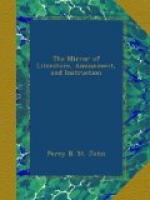The length of the bird from the tip of the bill to the end of the tail is 21 inches 6 lines; and the length of the longest quill feather is 12 inches six lines.
* * * * *
THE COCK OF THE PLAINS,
Tetrao,[3] (Centrocercus,) Urophasianus,
Swainson.
This bird, which was first mentioned by Lewis and Clark,[4] has since become well known to the fur traders that frequent the banks of the Colombia. Several specimens have been sent to England by the agents of the Hudson’s Bay Company. Mr. David Douglas has published the following account of the manners of the species, the only one hitherto given.
[3] Or Grouse.
[4] The adventurous travellers to the Source of the Missouri.
“The flight of these birds is slow, unsteady, and affords but little amusement to the sportsman. From the disproportionately small, convex, thin-quilled, wing,—so thin, that a vacant space, half as broad as a quill appears between each,—the flight may be said to be a sort of fluttering more than any thing else: the bird giving two or three claps of the wings in quick succession, at the same time hurriedly rising; then shooting or floating, swinging from side to side, gradually falling, and thus producing a clapping, whirring sound. When started, the voice is ‘cuck, cuck, cuck,’ like the common pheasant. They pair in March and April. The love-song is a confined, grating, but not offensively disagreeable, tone,—something that we can imitate, but have a difficulty in expressing—’Hurr-hurr—hurr-r-r-r hoo,’ ending in a deep hollow tone, not unlike the sound produced by blowing into a large reed. Nest on the ground, under the shade of Purshia and Artemisia, or near streams, among Phalaris arundinacea, carefully constructed of dry grass,




